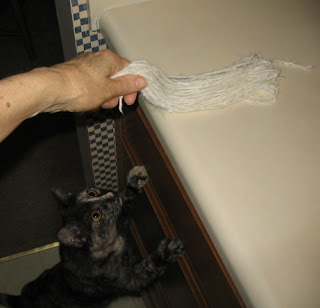 By Leigh
By LeighOne of the charming characteristics of Angora yarn is its tendency to “bloom.” No sooner is one's yarn finished than the fine, smooth fibers begin unspin and work their way out of the yarn. In the process, they create a soft fluff about the yarn known as “halo.” However, this also means that the fibers work their way out of the yarn completely and shed all over the place!
The more loosely spun the yarn is, as in this close-up of one of my first angora yarns (from Cricket) on the left, the more the yarn blooms and the easier it sheds. The halo is also developed as the yarn is handled or the garment is worn. Spinning a firmer yarn helps, but doesn't stop this.
This is true not only of 100% Angora yarns but of blends, such as the sleeve of this Angora / Jacob / Merino blend sweater (below), as well.
 While many people love the soft halo effect, most folks don't like the shedding. The way to prevent this is to abuse the yarn. Sounds terrible, I know, but that's what they call it! Perhaps “wash and whack” would be a better way to say it.
While many people love the soft halo effect, most folks don't like the shedding. The way to prevent this is to abuse the yarn. Sounds terrible, I know, but that's what they call it! Perhaps “wash and whack” would be a better way to say it.The idea here is to take advantage of Angora's excellent felting quality by fulling the yarn in two steps.
 Firstly in the washing. All that is required is warm water, a squirt of Dawn dishwashing liquid (or whatever you like to wash wool in), and a rough hand: squeeze the yarn vigorously.
Firstly in the washing. All that is required is warm water, a squirt of Dawn dishwashing liquid (or whatever you like to wash wool in), and a rough hand: squeeze the yarn vigorously.In her video, Spinning Exotic Fibers & Novelty Yarns, Judith MacKenzie McCuin recommends using 2 pans of water, one hot and the other very cold. She works the yarn back and forth between the two, further shocking the fibers into felting.
Rinse thoroughly and squeeze as much water out as possible. I like to squeeze it in a towel.
The second step is the whacking:
 Hold the damp skein tightly in one hand and whack it firmly against a hard surface like a counter top. Whack hard! And loud! A bunch of times. Like cracking a whip. No wimpy whacking allowed. Then rotate the yarn and whack some more.
Hold the damp skein tightly in one hand and whack it firmly against a hard surface like a counter top. Whack hard! And loud! A bunch of times. Like cracking a whip. No wimpy whacking allowed. Then rotate the yarn and whack some more.This step was not easy to get a picture of. I couldn't coordinate the whack, flash, and aperture opening(!) As you can see, Catzee was plainly curious. She would run off with every whack, but couldn't stay away for long as she just had to see what was going on.
 After whacking I lay it loosely on a towel to dry. This textured yarn was spun from Rudy, using the "out of hand" spinning technique.
After whacking I lay it loosely on a towel to dry. This textured yarn was spun from Rudy, using the "out of hand" spinning technique.Next - a mini-gallery of some of my handspun Angora yarns.
© 7 March 2007 at http://leighsfiberjournal.blogspot.com
Related Posts:
Angora Rabbit 1 - My Bunnies
Angora Rabbit 2 - The Fiber
Angora Rabbit 3 - Spinning the Fiber
Angora Rabbit 5 - A Few Handspun Yarns
4 comments:
I've been fortunate to take several classes with Judith and learned about fulling and whacking several years ago. It makes such a huge difference to the yarn, no matter what I've spun. It seems to make the yarn relax and smooth out all the lumpiness.
Leigh - I've really been enjoying your Angora posts! I'm curious to see what the "abused" yarn looks like up close and also worked up in something. Is it still soft and furry, but just doesn't shed, or does that "halo" go away completely?
Cathy, yes, abused yarn is still soft and fluffy as the fibers tend to try to come undone during the abusing process. I read that the halo can be controlled most through twist, though I've not experimented with this. It would be a good project!
I have an Angora rabbit, a fuzzy lop, and some sheep. The sheep are Columbia, Romney mix, and Jacob. I haven't sheared the Jacob yet because he is a ram with horns, and I have two large feedsacks already of unprocessed wool to work with. When it gets hotter I will, but for now it's easier to store the wool on him than in my bedroom. LOL
I just finished experimenting spinning some of my rabbit Angora in with the Columbia and Romney (brown wool and white) to see what kind of goodies I can make. It is still on the drop spindle for now. Some of the Angora didn't quite card into the sheep wool fully, so there is "marbling" or ribbons of straight Angora worked into the wool. When spinning, it made white stripes like a candy cane in the brown wool. I'm curious to see if my yarn is going to completely fall apart now when I make a garment with it. I was carding and I saw it doing this, but decided to leave it, because I wanted to see what it would do. Your thoughts? Will my scarf or whatever fall apart? I kind of wanted to do socks or something for Christmas.
Post a Comment